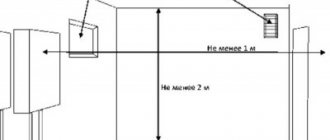Gas generator design
The device can be of any size from 100 to 1000 liters (depending on the required power).
Divided according to the gasification process:
- Direct.
- Converted.
- Transverse type.
In the transverse design, gases flow horizontally through the device. From bottom to top - in a straight pattern, and in reverse - from top to bottom.
The device of the ACC-2000 gas generator
The most optimal option for the reverse gasification principle. The container has double walls (which is fireproof), and the hot gas additionally heats and dries the fuel located above the combustion chamber.
The reverse gas flow circuit is best suited for use on a car.
Valuable information on gas generators
Sometimes the expectations of private home owners who are thinking about purchasing or making a gas generator themselves turn out to be too rosy compared to the real situation.
There is an opinion that the efficiency of the gas generator, which is about 95%, significantly exceeds the efficiency of a conventional floor-standing gas boiler, which reaches 60-70%. These figures are generally correct, but it is incorrect to compare them.
In the manufacture of a homemade gas generator, used gas cylinders, cans, kitchen utensils, etc. are used. The practically free device economically consumes not the most expensive fuel with fairly high performance
The first indicator reflects the efficiency of production of combustible gas, and the second - the amount of heat obtained during operation of the boiler. In both cases, wood burns, but the result of this process is qualitatively different. If in the future the combustible gas obtained by pyrolysis combustion of wood is used to heat a home, such a comparison can be made.
It is also worth remembering that homemade gas generators, although they can work with high efficiency, are rarely as effective as industrial models. This point should be taken into account at the stage of designing the unit and calculating the cost of the project and its expected efficiency.
If the need to create a gas generator is due only to the desire to improve the heating system at home, you should pay attention to a similar device - a pyrolysis boiler, which operates on very similar principles. Its main difference from a gas generator is that the resulting gas is immediately burned, and the resulting energy is used to heat the coolant in the home heating system
In such a device, an additional combustion chamber is installed, into which it is necessary to organize a separate air supply. If you need to heat the house using a gas generator, you will also need to choose a convector for heating. This will increase the cost of upgrading or installing heating. It is necessary to calculate whether in this case the game is worth the candle?
An important point is proper maintenance of the gas generator during its operation. Advertising claims that this is a universal device in which everything burns: from sawdust to freshly cut wood.
But the advertisement is silent about the fact that when loading wet raw materials, the amount of combustible gas produced can be reduced by 25% or more.
The best fuel for a household gas generator is charcoal. When burning it, too much energy is not spent on evaporating excess moisture, which allows you to obtain the maximum amount of combustible gas
The optimal fuel for a gas generator, according to experts, is charcoal. When it burns, a minimal amount of energy is consumed to evaporate moisture, which allows the pyrolysis process to be accelerated.
Vehicle owners can count on a gas generator not only for heating, but also for the operation of their vehicle. Indeed, in Europe, many motorists have quite successfully adapted their vehicles to run on wood. But most often these are compact and durable devices made of thin and durable stainless steel.
The cost of such units, even those made independently, is not at all small. In Russian realities, gas generators for cars are made from improvised materials and installed on trucks.
The effect of their operation is low; usually the presence of such a unit is accompanied by such phenomena as prolonged ignition, the need to constantly operate the engine at high or medium speeds, which contributes to its rapid wear.
For a car, it is best to use a high-quality gas generator made of durable stainless steel, having a relatively light weight and compact dimensions.
An interesting option for using a gas generator in private households is the use of combustible gas for a home power plant. Such a project is being implemented using a diesel internal combustion engine.
conclusions
By creating a home gas generator for heating a house or running an internal combustion engine, you can get a device that allows you to partially replace natural gas and generate electricity, reduce the consumption of firewood by increasing efficiency and increase the burning time of one portion of solid fuel. The burning time of one load of wood in the firebox of a gas generator when using the resulting gas as an additional energy carrier reaches 8–20 hours. Operation of the equipment is quite simple, apart from periodic cleaning, and only the filter elements require replacement.
Despite these advantages, it is not advisable to install a homemade wood gas generator on a car. The savings will not be as significant as a decrease in the level of comfort of using the vehicle and unpredictable consequences for the internal combustion engine. The only compelling argument in favor of such a decision may be problems with purchasing gasoline.
An acceptable option is to assemble a gas generator for a private home with your own hands. In this case, the device will become a source of gas for a heating boiler, gas stove and small home power station.
Principle of operation
In order to understand how to properly use a generator at home, it is worth understanding the basics of its operation. This will allow you to understand whether the costs of materials are worth the investment and how quickly they will pay off. In addition, the gas generator has its own scope of application.
In itself, this device is a complex of components and assemblies that ensure the production of gas from solid fuel. The resulting material is used in the operation of the internal combustion engine. But there is a nuance: the design of generators may differ from each other - it all depends on the type of solid fuel.
One of the most common, and perhaps affordable, types of fuel is firewood. When wood is burned in a sealed space, the process produces flammable gases such as carbon monoxide, hydrogen, methane and other unsaturated carbons. This mixture additionally contains ballast gases - oxygen, water vapor, carbon dioxide and nitrogen. But the efficiency of the gas generator does not simply depend on the production of such a combustible mixture. It must become suitable for use for specific purposes. Therefore, the entire process goes through the required stages:
- Gasification. Here the solid fuel must completely burn out and enter the smoldering stage. This process occurs with a small amount of oxygen - 30-35%.
- The first and second stages of cleansing. All volatile substances resulting from smoldering are separated using a dry vortex filter-cyclone and fed into a separate chamber - a scrubber. Here water is already used, which carries out another cleaning of the combustible stream.
- Cooling. During the process of combustion and smoldering, all substances acquire a fairly high temperature - from 700 degrees and above. To reduce their performance, an air or water heat exchanger is used. After this, the mixture will have to undergo another cleaning.
- Dispatch. After all stages, the resulting finished substances can be pumped into a distribution tank using a compressor, or immediately enter the internal combustion engine.
In fact, the full cycle is quite complex, and therefore takes time. But the main component is the gas generator itself. Basically, it is a metal column of cylindrical or rectangular shape, tapering at the end. The internal structure has several air pipes through which oxygen is pumped in and gas comes out. At the top there is a lid through which firewood is loaded.
If you don’t delve too deeply into the basis of chemical processes, the process of gas production looks like this: they loaded fuel - it burned/decayed - a gas mixture was obtained. In order for the final product to have the necessary properties, there are many components inside the structure that clean and cool the mixture. If we talk about home gas generators, then you can use a simpler design. This turns out to be both simpler and cheaper.
Manufacturing a wood-burning gas generator for a private home
An important nuance that should be taken into account when creating a wood-burning gas generator with your own hands is the equipment diagram. It indicates not only the elements, but also the directions of movement of air and gas flows. You can find different options for gas generators on the Internet, and one of the most popular among domestic homeowners is a device assembled on the basis of a 200-liter metal barrel.
Schematic diagram of one of the wood-burning gas generators
A wood hopper is installed in the upper part of the cylindrical body, the volume of which is taken to be approximately 60–70 liters. A zigzag pipe is usually used as a generator filter element. You can also take the body of a fire extinguisher for this. The filter is equipped with a tap that allows you to collect and remove condensate that appears when raw wood is burned.
Homemade wood gas generator
The principle of operation of a wood-burning gas generator, the device and drawing of which are used to create a home-made device, is as follows:
- the firewood placed in the bunker ends up in the firebox and burns;
- during the combustion process, gas is formed, which enters the skirt in the upper part through a coarse cleaning system;
- When passing through the cooling filter, the gas cools down and is discharged through a special pipe (for example, to the internal combustion engine or into an additional combustion zone).
When wet wood burns, gas enters the “skirt” and upon contact with cold air leaves a small amount of water. The liquid passes through a separator made of a pipe with a ribbed plate inserted inside and is drained out. To increase the efficiency of the boiler, the purified gaseous fuel obtained from burning wood is used for additional heating, entering the second combustion zone. In this case, only carbon dioxide (CO₂) comes out.
The video below shows a version of a gasgen for heating made of sheet metal.
When creating gasgen with your own hands, you can include a boiler in the design. The water is heated by the return combustible gas, which is further cooled during this process. On average, such equipment provides heating of 5–10 liters of water per minute by 20–30 degrees.
Features of installation and use
The location for the equipment is selected taking into account the odorlessness of the gas produced and its danger to the human body. Therefore, it is advisable to install homemade wood-burning gas generators in separate rooms. The room must meet the same requirements as the boiler room - have good forced ventilation and a volume of at least 15 cubic meters.
To remove gas, a special gas pipe is used, secured with clamps to the generator pipe. The installation must have a base made of fireproof materials. It is also worth noting that the work on assembling the gas generator must be carried out by a professional - if there is no experience in carrying out such work, it is better to refuse making a homemade device for producing gas or increasing the efficiency of wood combustion.
Automotive gas generator
The difference between a gas generator for a vehicle is its compactness and increased reliability - although even such characteristics do not allow the car to be driven at high speed. However, acceleration to 80–90 km/h is quite possible. The material used to manufacture a car gas generator is most often metal containers. Serial production involves the use of stainless steel, which reduces the weight of the generator and improves aesthetic parameters. Handicraft production of such devices leads to efficient, but not very neat-looking and heavy wood-burning stoves, the gas from which is transferred to the gas engine of the car.
Niva car powered by a gas generator
An old propane tank can be a good option for creating a gas fuel generator for a small car. For the internal part of the device circuit, the use of a receiver from a 20 or 40 liter truck is used. Thin metal is chosen for the grate, and ordinary heating pipes are used for the pipes.
Grate of an automobile gas generator
The lid with fasteners is made from the top of the cylinder or sheet steel. It is sealed using an asbestos cord treated with graphite impregnation. A coarse filter is made from an old fire extinguisher or a piece of pipe of similar length. A cone-shaped nozzle is installed at the bottom of the filter element through which ash will be discharged. The top of the pipe or fire extinguisher is covered with a lid with a pipe built into it.
Gas generator with filter
The presence of coolers, which are often used as bimetallic heating radiators, is required for two reasons:
- too hot gas has a low density and cannot ensure efficient operation of the internal combustion engine;
- When hot gas comes into contact with heated engine components, a flash may occur.
Another important design element is the mixer, which allows you to adjust the proportions of the gas-air mixture. If you do not change the fuel concentration, the engine will receive gas with a calorific value of 4.5 MJ/m3, which is 7.5 times less than that of conventional propane. By changing the proportion using a special damper, the gas-air mixture is brought into line with ordinary gas.
Check out a series of videos on creating a gas generator for the Moskvich car.
Installation on a car
Before installing a wood-burning gas generator, you need to choose a suitable location. On trucks, the installation is located between the cab and the body, on buses - on the side (driver's side). For a passenger car, two options are allowed - installation in the trunk or on a separate trailer.
The gas generator in the luggage compartment looks neater and does not interfere with the design of the vehicle. But using such a device is inconvenient, and there is practically no space left for transporting goods. Separate installation of the device on the trailer not only saves space in the trunk, but also simplifies equipment repair. In addition, the trailed gas generator can be disconnected, if necessary, by switching the car to gasoline or bottled gas. The disadvantage of the option with a trailer is the increase in the total length of the vehicle, which creates problems when parking, and additional costs for purchasing a trailer.
One of the ways to place a wood-burning gas generator in a car
Method number 3 - Homemade stations
Also, many craftsmen create homemade stations (usually based on a gas generator), which they then sell.
All this indicates that you can independently make a power plant from available materials and use it for your own purposes.
Next, let's look at how you can make the device yourself.
We recommend: Cooling towers of open and closed types: their design, operating modes, photos
Based on a thermoelectric generator.
The first option is a power plant based on a Peltier plate. Let us immediately note that a device made at home is only suitable for charging a phone, a flashlight, or for lighting using LED lamps.
For production you will need:
- A metal body that will play the role of a furnace;
- Peltier plate (purchased separately);
- Voltage regulator with installed USB output;
- A heat exchanger or just a fan to provide cooling (you can take a computer cooler).
Making a power plant is very simple:
- We make a stove. We take a metal box (for example, a computer case) and unfold it so that the oven does not have a bottom. We make holes in the walls below for air supply. At the top you can install a grate on which you can place a kettle, etc.
- We mount the plate on the back wall;
- We mount the cooler on top of the plate;
- We connect a voltage regulator to the terminals from the plate, from which we power the cooler, and also draw terminals for connecting consumers.
POPULAR WITH READERS: What are smart sockets, their types, design and operating principle
It works simply: we light the wood, and as the plate heats up, electricity will begin to be generated at its terminals, which will be supplied to the voltage regulator. The cooler will start working from it, providing cooling of the plate.
All that remains is to connect the consumers and monitor the combustion process in the stove (add firewood in a timely manner).
Based on a gas generator.
The second way to make a power plant is to make a gas generator. Such a device is much more difficult to manufacture, but the energy output is much greater.
To make it you will need:
- Cylindrical container (for example, a disassembled gas cylinder). It will play the role of a stove, so hatches should be provided for loading fuel and cleaning solid combustion products, as well as an air supply (a fan will be required for forced supply to ensure a better combustion process) and an outlet for gas;
- A cooling radiator (can be made in the form of a coil) in which the gas will be cooled;
- Container for creating a “Cyclone” type filter;
- Container for creating a fine gas filter;
- Gasoline generator set (but you can just take any gasoline engine, as well as a regular 220 V asynchronous electric motor).
After this, everything must be connected into a single structure. From the boiler, gas should flow to the cooling radiator, and then to the “Cyclone” and a fine filter. And only after that the resulting gas is supplied to the engine.
This is a schematic diagram of the manufacture of a gas generator. Execution can be very different.
For example, it is possible to install a mechanism for forced supply of solid fuel from a bunker, which, by the way, will also be powered by a generator, as well as all kinds of control devices.
When creating a power plant based on the Peltier effect, no special problems will arise, since the circuit is simple. The only thing is that you should take some safety measures, since the fire in such a stove is almost open.
But when creating a gas generator, many nuances should be taken into account, among them is ensuring tightness at all connections of the system through which gas passes.
In order for the internal combustion engine to operate normally, you should take care of high-quality gas purification (the presence of impurities in it is unacceptable).
The gas generator is a bulky design, so it is necessary to choose the right place for it, as well as ensure normal ventilation if it is installed indoors.
Since such power plants are not new, and they have been manufactured by amateurs for a relatively long time, a lot of reviews have accumulated about them.
Basically, they are all positive. Even a homemade stove with a Peltier element is noted to completely cope with the task. As for gas generators, a clear example here is the installation of such devices even on modern cars, which indicates their effectiveness.
Advantages and disadvantages of the system
Gas generators are extremely easy to use. If the unit is made correctly, in compliance with all safety requirements, fuel can be loaded into it very rarely. For example, you can load firewood into the chamber only once a day, and if charcoal is used as fuel, once a week will be enough.
Industrial models of household wood gas generators are extremely convenient and safe, but the cost of such a device is usually very high
But this applies, rather, to industrially manufactured devices. Of course, the operation of a homemade device should be carefully monitored. The temperature of the hot gas can be very high, and the risk of fire also increases significantly.
Wood is an affordable material. Firewood, wood chips, sawdust, any waste from the wood industry, and cellulose-containing materials can be fed into the loading chamber of the gas generator. Dry and light charcoal is ideal as fuel. If the size of the bunker allows, you can load firewood into it even without preliminary chopping, entirely.
Almost any material containing cellulose is suitable for combustion in a gas generator, but it is important not to forget about the acceptable level of moisture content of such fuel in order to increase the efficiency of the device
The product obtained as a result of combustion, flammable gas, can be used to solve various problems: heating a house, operating a car’s internal combustion engine, even generating electricity. But it’s worth remembering the “cons” of this useful device.
To begin with, an industrial model of a gas generator, reliable, safe and convenient, is quite expensive. Not every home or cottage owner can afford such a unit. But creating a homemade gas generator, even from scrap materials, can cost a pretty penny.
It is not always possible to use any available materials for it. All parts of the unit must be very durable and able to withstand high temperatures. You will definitely need a welding machine, as well as skills to work with it. The metal will have to be cut and welded.
The fuel for the wood gasifier must be of a size and configuration that will allow it to move freely down the hopper to the combustion chamber
When calculating how much it will cost to create a homemade sawdust gas generator, you should also take into account consumables. You will need cast iron to create the grate; it is quite possible that you will have to find or buy a special spring to make the lid.
Heat-resistant gaskets are also needed for hatches, for connecting individual elements of the device, etc. Before making a gas generator, you need to carefully calculate everything.
Another cost item for a gas generator is electricity, which is necessary to force air into the combustion chamber. If for some reason the power is cut off, the gas generator will not be able to operate.
This situation is unacceptable, since a decrease in combustion temperature can lead to contamination of the device with tar. As a result, you will have to stop the process, clean the gas generator, and then start it again.
Although it seems that you can load the gas generator with almost any fuel, you should still remember that it must gradually, as it burns, fall down the bunker. Therefore, firewood for the generator should be prepared by cutting it into elements of more or less equal size.











